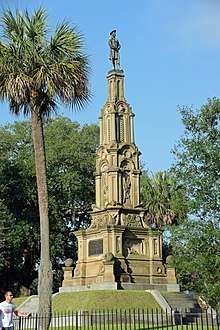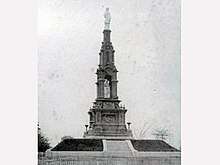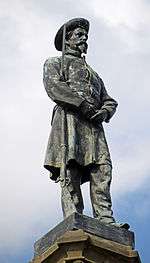Confederate Monument (Savannah, Georgia)
The Confederate Monument in Savannah, Georgia is a monument honoring Confederate soldiers who died during the American Civil War. Located in Forsyth Park, the monument was dedicated in 1875 and consists of a 48 foot (15 m) tall shaft topped with a bronze statue of a Confederate soldier. Two additional statues honoring notable Confederate army officers surround the monument, which is protected by a fence. The monument is one of the oldest and largest Confederate monument in Georgia.[1]
 Confederate Monument in Forsyth Park (2015) | |
 Location in Georgia (U.S. state)  Confederate Monument (Savannah, Georgia) (the United States) | |
| Coordinates | 32°4′2.0388″N 81°5′46.7808″W |
|---|---|
| Location | Forsyth Park, Savannah, Georgia |
| Designer | Robert Reid David Richards (Confederate Soldier statue) |
| Height | 48 feet (15 m) (Not counting base or top statue) |
| Beginning date | June 16, 1874 |
| Dedicated date | May 24, 1875 |
| Dedicated to | Confederate soldiers who died in the Civil War |
History

The idea for a public Confederate memorial in Savannah, Georgia began to gain traction in 1869, shortly after the relocation of Georgian soldiers killed at the Battle of Gettysburg to Laurel Grove Cemetery. Following this, the Ladies' Memorial Association in Savannah began to hold fundraising events, such as bake sales, raising almost $25,000 for the construction of a Confederate monument.[2] While the association originally planned for the monument to be located in the Confederate section of Laurel Grove Cemetery, they ultimately decided to erect the monument in Forsyth Park. This decision proved controversial with many in the general public, who pointed out that Forsyth Park was, at the time, on the outskirts of the city, but the association contended that the statue would be overshadowed by trees and surrounding architecture if it was placed in any of the squares of Savannah.[3] A public meeting at Independent Presbyterian Church in May 1874 settled the issue of location in favor of Forsyth Park.[3]
The association, not wanting to employ an architect from any northern states, instead commissioned Welsh-born Canadian architect Robert Reid to design the monument.[2] In April 1873, Reid visited Savannah at the invitation of the association and agreed with the location of Forsyth Park.[3] On June 16, 1874, the cornerstone for the monument was placed as part of a large festival that also helped to raise more funds for the monument's completion.[3] Reid was given a great deal of artistic liberty in designing the monument, with the association only requiring that the monument have a "life-sized figure worthy of the honor and respect due the common Confederate soldier."[4] Not wanting to use materials from northern states, the monument was constructed using sandstone from Nova Scotia and was constructed in Canada.[2] By the Fall of 1874, the monument was completed and shipped from Canada to Savannah via a British schooner to avoid transporting the monument over northern states.[5][6] The ship arrived in Savannah on December 25, 1874, but an issue with customs caused a delay in the transportation of the monument to the park.[5] By March 1875, much of the monument had been assembled, and on May 24, 1875, a dedication was held that attracted many and featured several notable Confederate generals as guests of honor.[3]
The monument consisted of a 48 foot (15 m) shaft on top of a 6 foot (1.8 m) earthen base.[1] On top of this pedestal was a life-sized statue of a woman in a robe named Silence, and at the base of the monument was another statue of a woman called Judgment.[5] Both statues had been shipped via New York City.[3] Despite the fanfare that had accompanied the monument's dedication, public opinion soon soured towards the monument. Many felt the statue was too ornate to represent the common soldier.[5] Writing about the monument several decades after its unveiling, Savannah mayor and historian Thomas Gamble called the monument "a distinct disappointment" that was "too symbolic" and "lacking in charm."[3]
Confederate Soldier statue

In early 1878, prominent Savannah citizen George Wymberly Jones De Renne proposed replacing Silence with a bronze statue of a Confederate soldier at his own expense. The Ladies' Memorial Association approved this idea in March and again in April, and following this, De Renne hired New York-based architect David Richards to craft the statue.[3] For the statue, simply called Confederate Soldier, De Renne and Richards wanted to depict a battle-worn soldier, which was rare at the time, as few Confederate monuments depicted soldiers.[3] Former Confederate Captain Hamilton Branch assisted Richards with the statue, sending him multiple articles of clothing he had worn in battle, as well as a rifle used during the war. According to Branch, the attire presented a soldier, "as he looked when he marched and fought, and not when he danced and fluted at home."[3] The statue depicted the soldier in parade rest, which, according to De Renne, "indicates submission to the inevitable, without excluding the idea of manly struggle to avoid it."[3] Richards used photos of Savannah veteran A. S. Bacon as a model.[7] On May 22, 1879, Confederate Soldier was hoisted atop the shaft, with Silence and Judgment removed from the monument.[3] Silence was relocated to the Confederate section of Laurel Grove Cemetery, while Judgment was sent to Thomasville, Georgia to be used as part of that town's Civil War memorial.[3][7]
Additional statues
In 1910, two statues honoring Confederate generals were moved next to the monument. Busts of Lafayette McLaws and Francis S. Bartow were moved from Chippewa Square in Savannah to make way for a monument honoring James Oglethorpe.[8]
Vandalism
On June 10, 2020, as part of George Floyd protests occurring both nationwide and in Savannah, the bust of McLaws was vandalized, with a white hood placed over the bust and a raised fist spray painted on the pedestal.[9][10] Following the incident, a descendant of McLaws offered to buy and remove the statue from the park.[11] A special task force is currently being convened by the city to address the future of the monument, with proposed changes including the relocation of the two busts and renaming the monument from "Confederate Monument" to "Civil War Memorial".[12] A similar task force organized in 2018 had proposed relocating the busts of Bartow and McLaws to Laurel Grove Cemetery.[8]
References
- Carlisle & Carlisle 2019, p. 67.
- Daiss 2002, p. 59.
- Jordan 2017.
- Daiss 2002, pp. 59–60.
- Daiss 2002, p. 60.
- Guss 2002, p. 113: "Sentiments were still strong against the North after the war – so much that the monument was put on a ship and sent down to Savannah so it would not have to travel through Northern territory."
- Daiss 2002, p. 61.
- Curl 2018.
- Toone 2020.
- Merrigan 2020.
- Komanecky 2020.
- WTOC-TV 2020.
Bibliography
- Carlisle, Rodney; Carlisle, Loretta (2019). Savannah in History: A Guide to More Than 75 Sites in Historical Context. Rowman & Littlefield. ISBN 978-1-68334-028-7 – via Google Books.CS1 maint: ref=harv (link)
- Curl, Eric (February 14, 2018). "Savannah approves changes to Confederate Memorial". Savannah Morning News. GateHouse Media. Retrieved June 23, 2020.CS1 maint: ref=harv (link)
- Daiss, Timothy (2002). Rebels, Saints, and Sinners: Savannah's Rich History and Colorful Personalities. Pelican Publishing. ISBN 978-1-4556-1089-1 – via Google Books.CS1 maint: ref=harv (link)
- Guss, John Walker (2002). Fortresses of Savannah, Georgia. Arcadia Publishing. ISBN 978-0-7385-1468-0 – via Google Books.CS1 maint: ref=harv (link)
- Jordan, Michael L. (2017). Hidden History of Civil War Savannah. Arcadia Publishing. ISBN 978-1-62585-180-2 – via Google Books.CS1 maint: ref=harv (link)
- Komanecky, DeAnn (June 18, 2020). "Family of Confederate leader offers to purchase vandalized Savannah memorial". Bluffton Today. Gannett. Retrieved June 23, 2020.CS1 maint: ref=harv (link)
- Merrigan, JoAnn (June 11, 2020). "Confederate monument vandalized in Forsyth Park". WSAV-TV. Nexstar Media Group. Retrieved June 12, 2020.CS1 maint: ref=harv (link)
- Toone, Stephanie (June 11, 2020). "Georgia Confederate monument vandalized with white hood, black fist". The Atlanta Journal-Constitution. Cox Enterprises. Retrieved June 12, 2020.CS1 maint: ref=harv (link)
- "Special meeting set for Thursday to discuss Confederate Monument at Forsyth Park". WTOC-TV. Gray Television. June 18, 2020. Retrieved June 23, 2020.
External links
